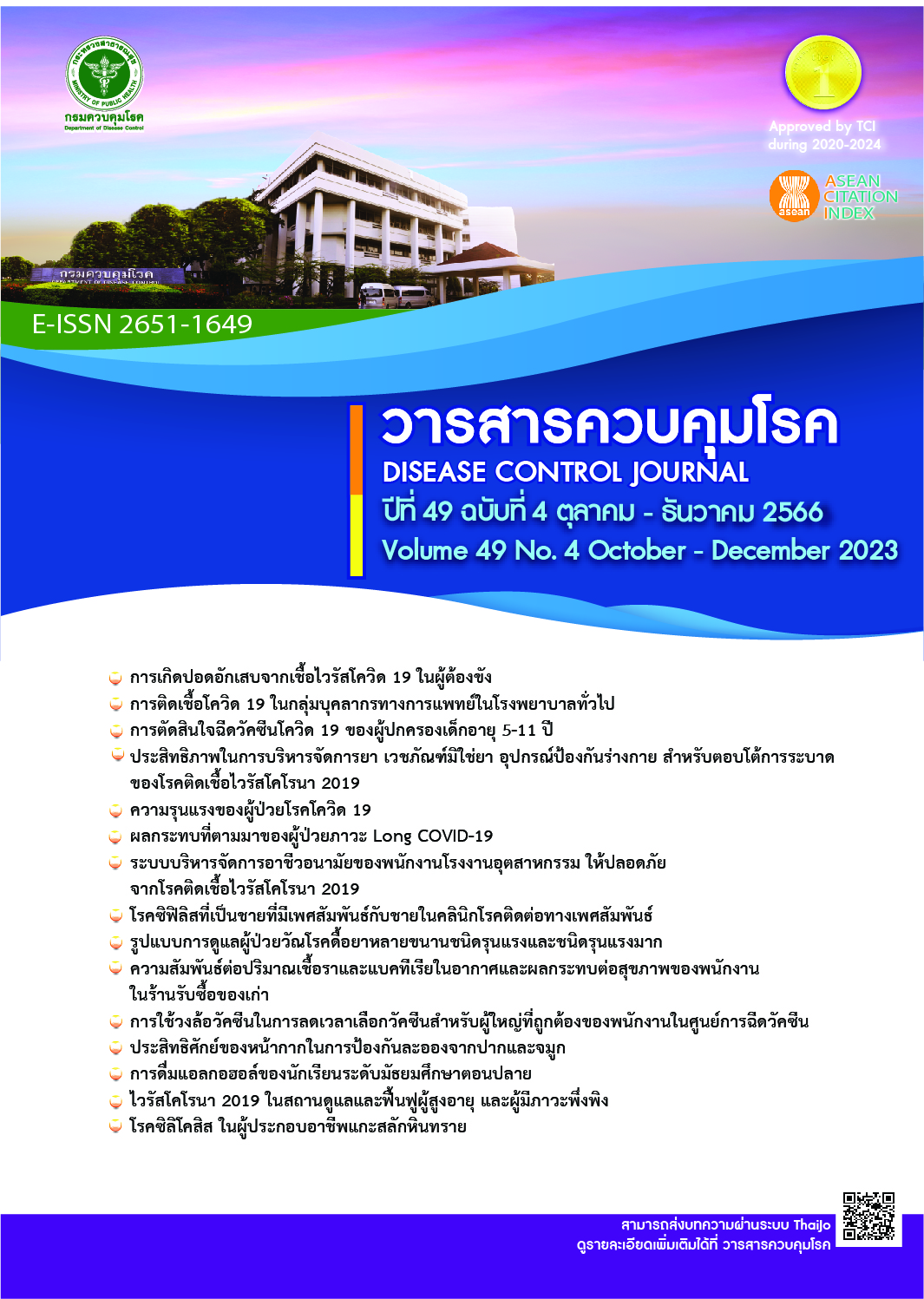Incidence of COVID-19 infection among healthcare workers in secondary care hospital, Nakhon Ratchasima province
DOI:
https://doi.org/10.14456/dcj.2023.57Keywords:
healthcare workers, COVID-19, occupational infectionAbstract
This study was a retrospective study purposed to describe 1) the incidence of occupational COVID-19 infections in healthcare workers and 2) the factors associated with occupational COVID-19 infections.
Secondary data were collected from October 1, 2021 to September 30, 2022, involving a total of 663 healthcare workers. The data were collected by using data recording forms for COVID-19 post-exposure risk assessment and medical records. Descriptive analysis presented as percentages and frequencies, while factors related to occupational COVID-19 infections were analyzed by using multivariate logistic regression
statistics. The result revealed an incidence of 16.6% for occupational COVID-19 infections. The highest infection risk was observed in the supporting department, with an odds ratio of 3.5 (p-value<0.05). Healthcare workers using inappropriate personal protective equipment had a 3.8 times higher risk of infection compared to those with appropriate personal protective equipment (p-value<0.05). Multivariate logistic regression analysis identified two significant factors associated with occupational COVID-19 infections. The highest infection risk was observed in the supporting department, with an adjusted odds ratio of 3.2
(p-value<0.05). Healthcare workers using inappropriate personal protective equipment had a higher risk of infection than those with appropriate personal protective equipment, with an adjusted odds ratio of 3.5
(p-value<0.05). According to this study, it is recommended to enhance prevention measure and provide intensive infectious control training, especially for the supporting department.
Downloads
References
World Health Organization. WHO Coronavirus disease (COVID-19) Dashboard [Internet].
Geneva: WHO headquarters in Geneva; 2022 [cited 2022 Nov 18]. Available from: https://covid19.who.int/?mapFilter=cases
Ministry of Public Health (TH). Concerning the names and presenting symptoms of dangerous communicable diseases [Internet]. 2020 [cited 2022 Nov18]. Available from: https://ddc.moph.go.th/uploads/files/100202005 14102630.PDF (in Thai)
Schwartz J, King CC, Yen MY. Protecting health care workers during the COVID-19 Coronavirus outbreak–lessons from Taiwan's SARS response. Clin Infect Dis. 2020;71:858-60.
Sirijatuphat R, Leelarasamee A, Horthongkham N. Prevalence and factors associated with COVID-19 among healthcare workers at a
university hospital in Thailand. Medicine [Internet]. 2022 [cited 2023 Jan 28];101(38):p.e30837. Available from: https://journals.lww.com/md- journal/Fulltext/2022/09230/Prevalence_and_factors_associated_with_COVID_19.82.aspx
Ochoa-Leite C, Bento J, Rocha DR, Vasques I, Cunha R, Oliveira Á, et al. Occupational
management of healthcare workers exposed to COVID-19. Occup Med. 2021;71(8):359-65.
Ramli NS, Fauzi MFM, Moktar NMA, Hajib N, Nawi AM. Prevalence, characteristics, and predictors of healthcare workers with COVID-19 infection in an urban district in Malaysia. Pan Afr Med J. 2022;41:243.doi:10.11604/pamj. 2022.41.243.33300
Lenggenhager L, Martischang R, Sauser J, Perez M, Vieux L, Graf C, et al. Occupational and community risk of SARS-CoV-2 infection among employees of a long-term care facility: an observational study. Antimicrob Resist Infect Control. 2022;11(1):51.
Bastuji-Garin S, Brouard L, Bourgeon-Ghittori I, Zebachi S, Boutin E, Hemery F, et al. The relative contributions of occupational and community risk factors for COVID-19 among hospital workers: the HOP-COVID cohort study. J Clin Med. 2023;12(3):1208. doi:10.3390/jcm1203120.
World Health Organization (TH). Situation of the coronavirus (COVID-19) outbreak in Thailand, February 2022. Weekly progress report on the situation in Thailand [Internet].2022 [cited 2023 Jan 28]. Available from: https://cdn.who.int/media/docs/default-source/searo/thailand/2022_02_02_tha-sitrep-221-covid-19-th.pdf?sfvrsn=97f3bf7b_5 (in Thai)
Stephen RI, Olumoh J, Tyndall J, Adegboye O. Risk factors for COVID-19 infection among healthcare workers in North-East Nigeria. Healthcare [Internet]. 2022 [cited 2023 Jan 28]; 10(10):1919. Available from: http://dx.doi.org/10.3390/healthcare10101919
Nguyen LH, Drew DA, Joshi AD, Guo CG, Ma W, Mehta RS, et al. Risk of COVID-19 among front-line health-care workers and the general community: a prospective cohort study. Lancet Public Health. 2020;5(9):475-83.
Quigley AL, Stone H, Nguyen PY, Chughtai AA, MacIntyre CR. Estimating the burden of COVID-19 on the Australian healthcare workers and health system during the first six months of the pandemic. Int J Nurs Stud. 2021;114: 103811. doi:10.1016/j.ijnurstu.2020.103811
Sabetian G, Moghadami M, Hashemizadeh Fard Haghighi L, Shahriarirad R, Fallahi MJ, Asmarian N, et al. COVID-19 infection among healthcare workers: a cross-sectional study in southwest Iran. Virology Journal. 2021;18(1):58. doi: 10.1186/s12985-021-01532-0.
Oksanen LAH, Sanmark E, Oksanen SA, Anttila VJ, Paterno JJ, Lappalainen M, et al. Sources of healthcare workers' COVID‑19 infections and related safety guidelines. Int J Occup Med Environ Health. 2021;34(2):239-49.
Al Abri ZGH, Al Zeedi MASA, Al Lawati AA. Risk factors associated with COVID-19 infected healthcare workers in Muscat Governorate, Oman. J Prim Care Community Health. 2021.
Jin YH, Huang Q, Wang YY, Zeng XT, Luo LS, Pan ZY, et al. Perceived infection transmission routes, infection control practices, psychosocial changes, and management of COVID-19 infected healthcare workers in a tertiary acute care hospital in Wuhan: a cross-sectional survey. Mil Med Res. 2020;7(1):24. doi:10.1186/s40 779-020-00254-8.
Dzinamarira T, Nkambule SJ, Hlongwa M, Mhango M , Iradukunda PG, Chitungo I, et al. Risk Factors for COVID-19 Infection Among Healthcare Workers. A First Report From a Living Systematic Review and meta-Analysis. Saf Health Work. 2022;13(3):263-268.
Mandić-Rajčević S, Masci F, Crespi E, Franchetti S, Longo A, Bollina I, et al. Source and symptoms of COVID-19 among hospital workers in Milan. Occup Med(Lond). 2020;70(9) :672-9.
Chatterjee P, Anand T, Singh KJ, Rasaily R, Singh R, Das S, et al. Healthcare workers & SARS-CoV-2 infection in India: A case-control investigation in the time of COVID-19. Indian J Med Res. 2020;151(5):459-67.
Harith AA, Ab Gani MH, Griffiths R, Abdul Hadi A, Abu Bakar NA, Myers J, et al. Incidence, prevalence, and sources of COVID-19 infection among healthcare workers in hospitals in Malaysia. Int J Environ Res Public Health. 2022;19(19):12485. doi:10.3390/ijerph19 1912485.
McGrath J, McAloon CG, More SJ, Garrett S, Reidy C, Geary U, et al. Risk factors for SARS-CoV-2 infection in healthcare workers following an identified nosocomial COVID-19 exposure during waves 1-3 of the pandemic in Ireland. Epidemiol Infect.2022;150:e186.
Downloads
Published
How to Cite
Issue
Section
License
Copyright (c) 2023 Disease Control Journal

This work is licensed under a Creative Commons Attribution-NonCommercial-NoDerivatives 4.0 International License.
Articles published in the Disease Control Journal are considered as academic work, research or analysis of the personal opinion of the authors, not the opinion of the Thailand Department of Disease Control or editorial team. The authors must be responsible for their articles.






